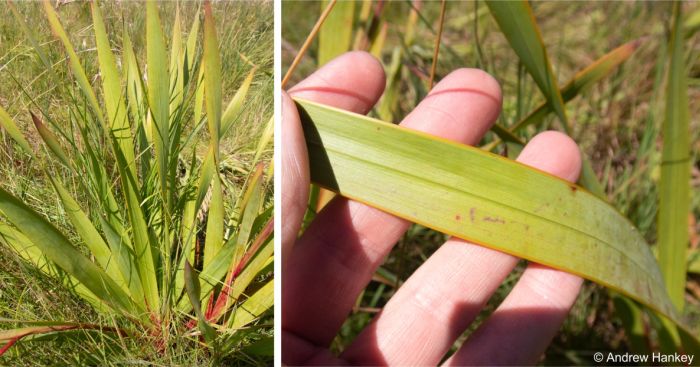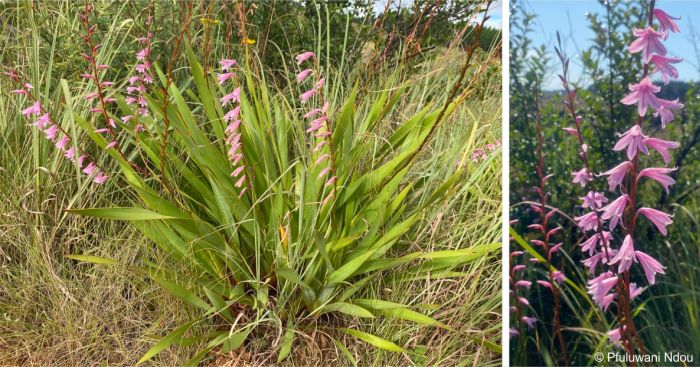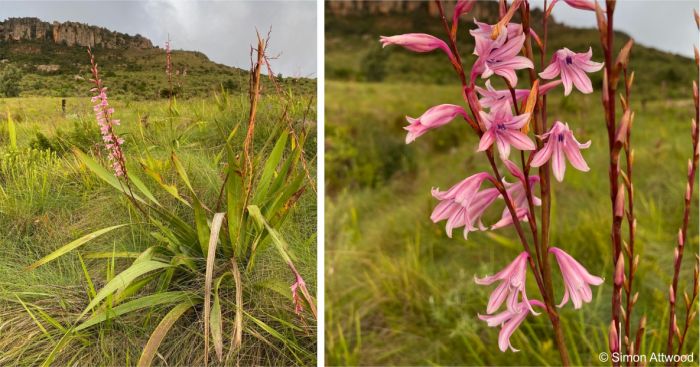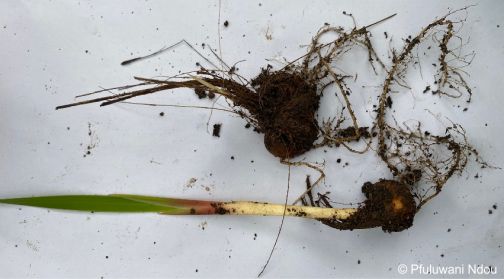Watsonia strubeniae
Watsonia strubeniae L.Bolus
Family: Iridaceae
Common names: Sabie watsonia Graskop watsonia, Struben’s watsonia (Eng.) Graskopse-kanolpypie (Afr.)
Introduction
Watsonia strubeniae is a charming grassland geophyte endemic to Mpumalanga, known for its tall spikes of pale pink autumn flowers, and it thrives in sunny, well-drained soil, making it an ideal garden plant.

Description
Description
Watsonia strubeniae is a medium-sized, deciduous geophyte that flowers in late summer and autumn, from late February to April. Typically, it grows to a height of 0.6–1 m, including its elegant floral spikes. The plant is supported by a corm (a bulb-like structure) that measures 30–40 mm in diameter, and is protected by grey, brown, coarsely netted tunics, extending into a neck-like formation. The corm is dark maroon on the inside. The stem of Watsonia strubeniae is erect, with 3 to 5 rigid, diverging branches. The plant produces 4 to 5 lanceolate leaves, shaped like a sword, with the lower 2 to 3 leaves being more or less basal, extending close to the base of the floral spike. These sword-shaped leaves are 14–20 mm wide, with a thickened midrib and margins that are hyaline (transparent). In the upper part of the stem, 1 to 2 sheathing bract leaves further contribute to its structure. Together, the basal and bract leaves form a lush green base, providing a striking contrast to the delicate floral spikes.

The main flower spike holds between 25 and 35 pale pink flowers, while the side spikes have fewer flowers. The outer bracts measure 9–14 mm in length, initially green but gradually turning dry and brownish in the upper half during the budding and early flowering stages. Over time, they become lacerated. These bracts either do not clasp the stem or do so only at the base. The inner bracts are shorter, with their tips either entire or forked for around 1 mm. The flowers, which are zygomorphic and pale pink, have a perianth tube with a lower section that is 7–9 mm long and about 1 mm wide at the bottom, widening to 3 mm at the top, barely protruding from the bracts. The upper section is horizontal and funnel-shaped, 6–7 mm long, with a diameter of 3 mm at the base expanding to 6 mm at the apex. The tepals are lance-shaped, ranging from 17–19 mm long. The inner tepals are 6 mm wide, while the outer ones are about 5 mm wide. They point forward, only spreading outward at the top third when fully opened. The filaments are 6–7 mm long, curve below the upper tepal, and the anthers, also 6–7 mm long, are violet and lie close together initially. The ovary is oblong and measures around 2 mm. The style arches over the filaments, branching at the tip of the anthers, with the style branches measuring 4–5 mm. The seed capsules are spherical, reaching up to 6 mm in length, and the seeds themselves are elongated and angular.

Conservation Status
Status
Watsonia strubeniae is assessed as Least Concern (LC) in the Red List of South African Plants.
Distribution and habitat
Distribution description
Watsonia strubeniae is endemic to the eastern Drakensberg Escarpment in Mpumalanga, specifically along the escarpment between Sabie and Pilgrim’s Rest. This region, characterized by its warm and temperate climate with summer rainfall, provides ideal conditions for the plant. Watsonia strubeniae demonstrates drought tolerance and can endure light frost. According to the SANBI Red list of South African plants, this species also occurs in Limpopo, however there is no evidence of this species being observed in Limpopo. Watsonia strubeniae thrives in well-watered grassland areas where shallow soils prevent the encroachment of forest, allowing it to flourish in its natural habitat.

Derivation of name and historical aspects
History
The genus Watsonia was named by Philip Miller, who worked as a Curator of the Chelsea Physic Garden, in honour of his friend Sir William Watson (1715–87), who was a physician and naturalist from London. This species is named after Miss Edith Struben (1898–1936), a botanical illustrator and painter, who collected specimens near Sabie and sent the plants to Kirstenbosch National Botanical Garden in 1930, which later flowered and formed the type collection. This species belongs to the Iridaceae, known as the iris family. Most watsonias are adapted to Mediterranean climate conditions (cool wet winters and hot dry summers), with few, including this species, being adapted to summer-rainfall climates.
Watsonia strubeniae was first collected in the 1920s near Pilgrim's Rest by both F.A. Rogers and G. Roe, working independently. Roe's specimen was labelled Watsonia roei in N.E. Brown's handwriting, but Brown passed away before he could formally publish the name and description. In 1926, Louisa Bolus described this species as a W. transvaalensis var. drakensbergensis, based on collections made by Rogers and Roe. In 1930 Bolus sent the plant to Kirstenbosch National Botanical Garden, those plants later became the type collection. By 1931, Bolus had also described W. strubeniae from a later collection, not realizing that it had already been named, at least as a variety of W. transvaalensis.
In 1938, Cape botanist G.J. Lewis introduced the synonym Watsonia alpina, distinguishing it from W. strubeniae due to its less dense spike and bracts that do not clasp the stem. However, more recent findings suggest these differences may not be significant, implying that Lewis’s separation of the species may have been inaccurate.
Watsonia strubeniae is closely related to Watsonia transvaalensis, but they can be distinguished by several features. W. strubeniae has small, pale pink flowers with a short perianth tube measuring 7–9 mm and tepals that are 17–19 mm long. It possesses short, dry bracts (9–14 mm) that do not clasp the stem, along with a branched stem and broader leaves with thickened margins. In contrast, W. transvaalensis exhibits larger flowers with tepals measuring 20–25 mm and longer bracts (13–28 mm). Its leaves are narrower with lightly thickened edges, and the stem is usually unbranched. W. transvaalensis is found between Graskop and Haenertsburg, while W. strubeniae occurs further south, around Sabie and Pilgrim’s Rest.
Ecology
Ecology
Watsonia strubeniae has tall flower spikes that lift its blooms higher than the surrounding grasses, making them more visible to flying pollinators and increasing the chances of pollination. The flowers have a tubular shape that suits sunbirds, allowing them to reach the nectar deep inside. The pale pink colour of the flowers also attracts insect pollinators like butterflies and bees, who are drawn to both the colour and the nectar.
This plant grows from corms, which help it survive during tough times like drought and fire, common in grasslands. The corms store water and nutrients, enabling the plant to regrow when conditions improve. Watsonia strubeniae is well adapted to survive fires; its underground corms protect the plant’s growth points, allowing it to recover after a fire. It grows especially well in the first and second years after a fire, producing many flowers and large quantities of globose capsules containing long, angular seeds. These seeds are dispersed by the wind, which boosts the chances of successful seedlings.

Uses
Use
Watsonia strubeniae is a unique and attractive choice for the garden, due to its tall spikes of pale pink flowers and sword-shaped leaves. Valued for its ornamental appeal, it is a popular addition to garden designs and can be used as a cut flower. The corms may be eaten by porcupines, as they feed on the corms of the Iris family, and while they are known to be edible, there is no record of them being consumed by humans.
Growing Watsonia strubeniae
Grow
Watsonia strubeniae is relatively straightforward to cultivate, provided its essential requirements for full sunlight and well-drained, fertile soil are met. This species exhibits a seasonal growth pattern, entering a dormant period during the winter months as the seasons change. Propagation can be achieved either through the division of corms or by planting seeds.
The most effective method for cultivating Watsonia strubeniae is through corm division. It is advisable to divide the plant every few years or when flowering diminishes, to encourage robust growth. For perennial cultivation, corms should be planted in late summer to ensure successful establishment before early winter, and left undisturbed during winter. In contrast, for annual cultivation, corms should be dug up in autumn and stored in a cool, dry location before being replanted at a depth of approximately 100 mm in early summer.
For seed propagation, sow the seeds to a depth of 3 mm in spring, ideally using a well-draining mix compost and sand in a ratio of 2:1. Plants grown from seeds typically require about three years to reach maturity and produce flowers, initially developing small, bright green leaves. Additionally, Watsonia strubeniae demonstrates drought tolerance and can endure light frost, making it a versatile choice for both garden beds and container planting.
References
- Attwood, S. 2024. Observation of Watsonia strubeniae, Blyde River Canyon Nature Reserve, Mpumalanga. iNaturalist. Online. https://www.inaturalist.org/observations/204961561.
- Cheers, G. 2004. Botanica: The illustrated AZ of over 10 000 garden plants and how to cultivate them. Tandem Verlag.
- Duncan, G. 2010. Grow bulbs. A guide to the cultivation of bulbs of South Africa and neighboring countries. Kirstenbosch Gardening Series. South African National Biodiversity Institute, Cape Town.
- Germishuizen, G. & Meyer, N.L. (eds) 2003. Plants of southern Africa: an annotated checklist. Strelitzia 14. National Botanical Institute, Pretoria.
- Gibson, D.J. 2009. Grasses and grassland ecology. Oxford University Press, Oxford.
- Goldblatt, P. & Manning, J.C. 2020. Iridaceae of southern Africa. Strelitzia 42. South African National Biodiversity Institute, Pretoria.
- Goldblatt, P. 1989. The genus Watsonia: A systematic monograph. National Botanic Gardens of South Africa, Cape Town.
- Grant, B.L. 2021. Growing Watsonias: Information On Watsonia Bugle Lily Plants. Gardening Know how. Online. https://www.gardeningknowhow.com/ornamental/bulbs/watsonia/growing-watsonia-corms.htm.
- Hankey, A. 2023. Observation of Watsonia strubeniae, Ehlanzeni, Mpumalanga. iNaturalist. Online. https://www.inaturalist.org/observations/154421671.
- Koekemoer, M., Steyn, H.M. & Bester, S.P. 2015. Guide to Plant Families of southern Africa. Strelitzia 31. 2nd ed., 2nd print. South African National Biodiversity Institute, Pretoria, South Africa.
- Lewis, G.J. 1938. Watsonia alpina. The Flowering Plants of South Africa 18 Plate 689.
- Linder, H.P. 1999. Plants of Mpumalanga. National Botanical Institute, Pretoria.
- Low, A.B. 1989. Indigenous plants for Cape coastal gardens: Part 2. The building blocks. Veld & Flora 75(4):108-111.
- Manning, J. 2009. Field guide to wild flowers of South Africa. Struik Nature, Cape Town.
- Mathew, B. & Swindells, P. 1994. The Complete book of bulbs, corms, tubers, and rhizomes: A step-by-step guide to nature's easiest and most rewarding plants. Reader's Digest Association, United Kingdom: .
- Raimondo, D., Von Staden, L., Foden, W., Victor, J.E., Helme, N.A., Turner, R.C., Kamundi, D.A. & Manyama, P.A. (eds) 2009. Red list of South African plants. Strelitzia 25. South African National Biodiversity Institute, Pretoria.
- Snijman, D.A. 1978. The genus Watsonia. Veld & Flora 64(3):93.
- The Original Pink Box. Blooming Beauties: Pink Flowers to Attract Pollinators. https://theoriginalpinkbox.com/pink-flowers-to-attract-pollinators. Accessed 9 Oct 2024.
- Van der Merwe, T. 2019. Observation of Watsonia strubeniae, Graskop, Mpumalanga. iNaturalist. Online. https://www.inaturalist.org/observations/20254678.
- Van Wyk, B. 2015. Pocket guide to wildflowers of South Africa. Penguin Random House, South Africa.
- Wikipedia. Edith Frances Mary Struben. https://en.wikipedia.org/wiki/Edith_Frances_Mary_Struben. Accessed 25 October 2024.
- Wikipedia. Watsonia (plant). https://en.wikipedia.org/wiki/Watsonia_(plant). Accessed 10 October 2024.
Credits
Pfuluwani Ndou
Lowveld National Botanical Garden
November 2024
Acknowledgements: the author thanks Troos van der Merwe, Simon Attwood and Andrew Hankey for providing images for this article.
Plant Attributes:
Plant Type: Bulb
SA Distribution: Mpumalanga
Soil type: Sandy, Loam
Flowering season: Late Summer, Autumn
PH: Acid, Neutral
Flower colour: Pink
Aspect: Full Sun
Gardening skill: Average
Special Features:
Horticultural zones









Rate this article
Article well written and informative
Rate this plant
Is this an interesting plant?
Login to add your Comment
Back to topNot registered yet? Click here to register.